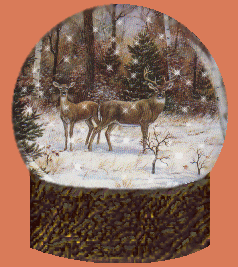

8.) When a deer is alerted by a sound, it cups both ears and points them in the direction from which it came, hoping for follow up sounds that will tell it what made the initial noise.
9.) If you see a deer suddenly lay it's ears back, the jig is up. You've blown your cover and the deer knows your there.
10.) On countless occasions deer have looked straight at me from as close as 20 yards, craning their heads from side to side to change perspectives, yet, they did not really see me. Provided there is no revealing scent or sound to arouse other senses the deer eventually think that I pose no threat, and they shortly returned to feeding.
11.) On the other hand, if the deer raises it's tail so that it is horizontal and pointing straight to the rear, you might as well take the best shot you can make. The animal is spooked and will almost always make a quick exit. Remember too, that bucks commonly extend tails straight back to intimidate subordinate bucks.
12.) Another kind of deer talk--it's a low gutteral, grunting noise. And it's made when bucks in rut are following the scent trail of a doe. This sounds like a hog in a full feeding trough. If you hear this sound, don't move. The bucks mind is fully occupied and the shot is usually an easy one.
